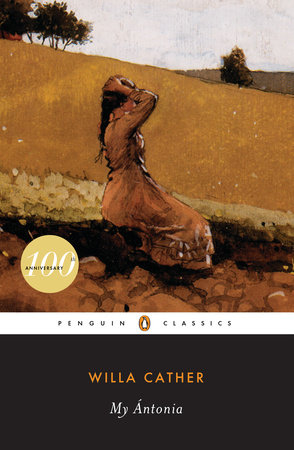essays
“Minari” Is an Intensely American Film—Why Do We Still See It as Foreign?
Lee Isaac Chung's film is classified as an "immigrant narrative," but Willa Cather's "My Ántonia"—which inspired it—is not

Minari, the gorgeous semi-autobiographical film written and directed by Lee Isaac Chung, opens with Monica Yi’s first glimpse of the wide, empty landscape that is her new home. Jacob, her would-be farmer husband, bounds out of the moving truck, ready to boost his children up into the stairless trailer. He digs his fingers through the tall grass, holding up the dirt. “This is the best soil in America,” he tells his increasingly panicked wife. “This is why I bought this place.”
The film follows the Yi family as Jacob pursues his dream of growing Korean vegetables in the Ozarks, embarking on a financially challenging and socially isolating life that threatens to break his marriage and family. Before being (rightfully) nominated for the Best Picture Oscar, Minari became the center of controversy surrounding the Golden Globes’ rule that candidates for Best Picture must be at least 51% in English. Otherwise, they are relegated to the “Foreign-language film” category, an award which Minari ultimately won.
I keep on returning to the feeling of watching the film, of seeing something distinctly representative of American culture.
I already knew about the Golden Globes insult before I sat down to watch Minari, but during the movie I realized just how absurd the “foreign-language film” categorization really is. The film just feels so American. When expressing outrage about the Golden Globes, critics and filmmakers tend to point out the circumstances under which the film is made. American director, American producer, filmed in America with American financial support. But I keep on returning to the feeling of watching the film, of seeing something distinctly representative of American culture. Lulu Wang, who directed The Farewell (also nominated for a foreign language Golden Globe), stated on Twitter, “I have not seen a more American film than Minari this year.” I repeated similar versions of this to my partner, even though I struggled at the time to pinpoint exactly what I meant.
The film immediately reminded me of a novel I had to read as part of my Midwestern high school curriculum, My Ántonia by Willa Cather. Told from the point of view of Virginia-born Jim Burden, Cather’s novel reflects on the narrator’s boyhood on a Nebraska farm and the family of immigrants from Bohemia (now part of the Czech Republic) next door, the Shimerdas. Their daughter and Jim’s boyhood love is the titular Ántonia. As a teenager, I fell deeply in love with the novel and the possibilities of literature that Cather opened up for me. Before reading the book, I’d never seen the Great Plains, the place I was from, so lovingly depicted in writing.
Chung, it turns out, loved the novel as well, and Cather is in fact essential to the origin story of Minari. In an article for the LA Times, Chung described calling out desperately for inspiration and hearing a voice in his head respond, “Willa Cather.” He went to the library and checked out what seemed to be her most popular book, My Ántonia. Chung also found himself in the novel, in the story of immigrants struggling with farm life. Like Jim, Chung also moved from the heartland and ended up among the East Coast elite. Chung in fact wanted to adapt My Ántonia into a film, but when he realized that Cather would not have wanted it, he turned to his own memories instead in a process that led him to write Minari.
Both My Ántonia and Minari are homesteading narratives, stories driven by the incredible difficulties of remote farming life. In such tales, the landscape becomes a character, both the antagonist and the beloved. During their first winter, the Shimerdas go hungry, their poorly-kept potatoes rotting and their sourdough bread turning out sooty and poor. In Minari, the soil that Jacob Yi loves betrays him when his well runs dry and he has to start paying for water to keep his Korean vegetables from withering. Both the film and the book also take care to depict the extreme beauty of their settings. In My Ántonia, Jim returns again and again to the light on the long red grass that will soon be cut down for farmland, and in Minari the camera pans across the wild woods as David runs in his cowboy boots and thigh-high shorts. At any moment in either work, a gorgeous hot summer day can bring immense pleasure or turn into a dangerous electrical storm.
Minari is not described as a film about the Ozarks, even though the land and place are essential to the story.
But while My Ántonia and Cather have become closely associated with the prairie, Minari is not described as a film about the Ozarks, even though the land and place are essential to the story. The Golden Globes did not even identify Minari with America because of the race of the main characters. Instead, the film has become a flashpoint for how narratives centering non-white characters are othered in the United States and what it even means to be an “immigrant story.”
Chung, in a New York Times roundtable interview with other Asian American directors, expressed discomfort with characterizing Minari as an “immigrant story” and said that he did not set out to make an “identity piece” or an “Asian American film.” Critics such as Jane Hu have identified this intense self-awareness and concern about falling into stereotype as “the most Asian American thing” about Minari, while also emphasizing that it is, of course, still a film telling a very specific story of an immigrant family. Other Asian American writers, such as Jay Caspian Kang in his profile of Minari lead Steven Yeun, also express discomfort with the phrase “immigrant stories,” which has been used to describe narratives that exploit the suffering of people of color for the entertainment of a white audience. The problem is not the term itself, but the way the phrase “immigrant story” traps characters of color in relation to whiteness. The use of “immigrant narrative” and “identity piece” in the current cultural conversation assumes that whiteness is the center against which everything that is not-white is compared to.
The reason Minari feels so American to me, I believe, is because it shows the Yi family struggling with ambition, optimism, and obligation while also being enormously unconcerned with white people, a reflection of my own personal American experience. The main axis of conflict is not between Korean and American culture, or the Yis and the white people around them, but among the Yis themselves. Jacob’s ambition is in direct conflict with Monica’s loneliness and concern for the health of her mother and son, and the core question of Minari is whether their marriage will survive. The film does not care about how the white peripheral characters see the Yis and shows very few interactions between the family and the white townspeople. And the Yis themselves are generally indifferent to whiteness, too occupied by their own lives to think about how they are received by others.
In my daily life as a Midwestern Asian turned East Coaster, I really only consider my relationship to whiteness when forced to.
In my daily life as a Midwestern Asian turned East Coaster, I really only consider my relationship to whiteness when forced to, an occasion that actually became more frequent once I moved to the cities. In graduate school, I faced a lot of assumptions about how Midwesterners must have treated me, meaningful pauses and implications about the “importance of my story” that were perhaps well-intentioned but left me feeling othered as well as confused, as I could tell my own experience did not line up with the speaker’s expectations. No matter the purpose, I’m always left after these interactions feeling at best uncomfortable and at worst violated or invisible, the actual story I am trying to tell subsumed under a broader cultural narrative.
American mainstream culture is still not used to seeing people of color depicted as actors, rather than those who are acted upon, as subjects directing their lives rather than objects suffering at the hands of others. The difference between what is assumed to be an “American story” versus an “immigrant story” is that in one we see whiteness doing or performing, and in the other we expect to see whiteness acting upon an other. Minari refuses this binary by leaving out the concerns of white people altogether.
Part of Minari’s success in avoiding the white gaze is the lack of white interference in its creation. After the Golden Globes, Chung revealed to CNN that he’d written two scripts for Minari, one with the Korean and one without, due to concern that he would not find distribution for the film if it was not in English. But his producer, fellow Korean American Christina Oh, pushed him to keep the film in Korean in order to preserve a picture of the way they grew up. Having other Korean Americans involved in the process helped him resist the pressures and expectations of white gatekeepers in the creation of his own particular story.
Minari refuses this binary by leaving out the concerns of white people altogether.
My Ántonia is actually considerably more concerned with xenophobia and culture clash than Minari. Part of this has to do with its first-person framing, as the reader sees the world through the perspective of Virginia-born Jim. When Ántonia moves to work for a family in town, she and the other foreign-born “hired girls” are viewed as exotic, potentially dangerous and deserving of pity as they have to work to send money back to their families. Town life turns out to be dangerous for Ántonia, as American-born white men try to assault and take advantage of her. Jim is criticized for being too interested in Ántonia and her friends, rather than girls of “his own set,” and when, as a college student in Lincoln, he reconnects with his old friend Lena Lingard, his professor worries that he will be ruined by the “handsome Norwegian.” He’s whisked off to Harvard instead to complete a law degree.
Like Jacob in Minari, Ántonia ultimately finds satisfaction once she moves back to the country and marries another Bohemian, turning away from town life. The world she creates with her husband and many, many children is inwardly focused and connected to the land. When Jim visits his old friend at the end of the novel, he finds a woman worn down by hard work but still full of purpose and life, caring for her orchards of fruit trees so she can make spiced preserves for kolaches to feed to her Bohemian-speaking children. Her family seems to have little interest in integrating or assimilating, preferring to keep company with other Bohemians. And, like the Yis, this inward turning allows Ántonia to integrate further with the landscape that she loves.
We seem to only notice foreignness when that foreignness is non-white.
Even though Cather is fixated on the foreignness of her characters, her books are not often characterized as “immigrant stories.” The difference, of course, is that she writes about European immigrants, who are not othered in American culture. Even now, one can still drive into a small town in my home state of Iowa and purchase an obscure Dutch pastry or, until recently, attend a Lutheran church service in German. But such markers are viewed more as quirks rather than cultural differences.
The double standard of the treatment of European vs. non-white immigrants is apparent in the Golden Globes. While films like Minari and Wang’s The Farewell were barred from Best Picture, Quentin Tarantino’s Inglourious Basterds was not, despite failing to meet the 51% English-language requirement due to its dialogue in French and German. Even The Crown, a show about the British monarchy, was treated more like part of American culture by the award association than Minari. We seem to only notice foreignness when that foreignness is non-white.
Much of Minari’s power comes from its disinterest in the language of white American culture, in what Chung referred to “the discourse that’s out there” during the New York Times roundtable interview. Chung, in his Golden Globes acceptance speech, slyly acknowledged the anger and controversy over the outdated rules that put his film in the wrong category while turning the attention back to his own vision. “Minari is about a family. It’s a family trying to learn how to speak a language of its own,” he said. It’s a language that ultimately exceeds—and expands—our culture’s limited understanding of what a movie like Minari can do.









